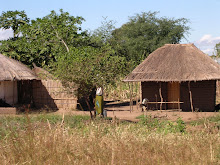Journey’s End
July 16 and 17, 2009
Leaving the beauty of Club Makakola was hard, but knowing that home was closer made it easier. We traveled well on the new road, stopped at the Mua vendors for a quick look and some purchases. I bought a lovely stylized statue of a woman, the face resembles those of statues by Zimbabwe carvers. Ann found a lovely mother and child and looked for a “tokoloshi” (a dream creature) but found none she liked. Students bought goat hide shields, which they learned later were from the Ngoni tribe. We made it to Mua Mission in time to get a guide for the tour of the museum before noon.
The museum is set up in three connected, circular hut-type rooms with a cement baobab tree in the center. The first room tells of the coming of the priest in 1902 to establish the mission. Mua comes from a “mangled” form of a Chiyao word for sugar cane, which is grown in the area abundantly. The priest couldn’t quite hear the pronunciation, so Mua actually is a word that means nothing in any language. Because the priest lived among the tribes for so long, they trusted him and welcomed him into the inner workings of tribal life. Otherwise, knowledge about the rituals would never be passed to outsiders. He was also able to amass an amazing number of artifacts from the three dominant tribes in the area: Chewa, Ngoni, and Yao.
The second room contains the artifacts of the rituals of the Chewa people. It takes your breath away when you enter the room with brightly colored masks and costumes hung everywhere. Here we see the masks and costumes of the Gule Wamkulu dancers (“spirit” dancers). These are the dances the students saw at Club Mak the night before, now being explained. When masked, a dancer takes on a different persona, he’s not himself and not accountable for his actions. The masks take many forms from human to animal. Circumcision of males is still a part of the “coming of age” ritual for boys. The guide tells us that circumcision (genital mutilation) of girls has died out now. For the most part that might be true, but in very rural villages there are still reports of this practice. The third room contains the Ngoni and Yao ritual artifacts. Ngoni’s were warriors who conquered the Chewas. They’re descended from Chaka Zulu. Many Ngoni are still leaders in Malawi. Yao are mostly Muslims because they inhabited the lake area, which was the slave route for the Arabs trading slaves on the east coast of Africa.
We set out for Lilongwe with students dreading the long drive, but we arrived before 4 p.m. at the Budget Lodge. This time students aren’t shocked by the differences and the hustle and bustle of Old Town. They’ve adjusted to Malawi “rhythms.” By 4:15 everyone was spread out doing his/her own thing – last minute bargaining, purchasing books and bags, super market purchases, ForEx, etc. By 5 they have convened at Ali Baba’s for pizza. By 6:30 everyone is back and settled in, rearranging their packing and getting ready for tomorrow.
This morning (Friday, the 17th) we’re in Pizza Land, the restaurant that serves breakfast for the Budget Lodge. We’re writing and eating and getting ready to post in an Internet Café down the street. By 10 we’ll load up and get on our way. We’re taking a young German man with us to the airport. That will save him a big taxi fare. We’re crowded but can always squeeze in one more for the 20 minute ride. When we board, the students will present Charles, our driver, with their gratuities and cheers. He always looks forward to this well-deserved extra. He’s a safe, thoughtful driver, and as the head driver at MIE, he is no doubt the best.
Our plane leaves at 1:00 p.m. We won’t arrive in Addis Ababa until 8:00 p.m. because we’re routed through Lusaka, Zambia. Students are happy to know that they can add Zambia to their list of countries on this trip: Malawi, Mozambique, Zambia, Ethiopia, and Italy because we stop in Rome for refueling. We arrive at 8:00 a.m. at Dulles. It’s been a memorable 28 days for everyone.
skip to main |
skip to sidebar
Followers
Blog Archive
-
▼
2009
(21)
-
▼
July
(15)
- Journey's End
- Two Worlds in One Day
- Tears and Laughter
- A Day of Downs and Ups
- Going in the Wrong Door
- A Day at a Community-based Orphanage
- A Day of Blessings
- Two Days at Mvuu Camp
- Celebrating Malawi Independence
- Hiking Mt. Mulanje
- Happy Fourth of July from Malaw
- Painting Blackboards: The End of a Good Week
- A Special Afternoon at Malika Catholic Church
- Enjoying the Differences
- A Day of Fellowship
-
▼
July
(15)
